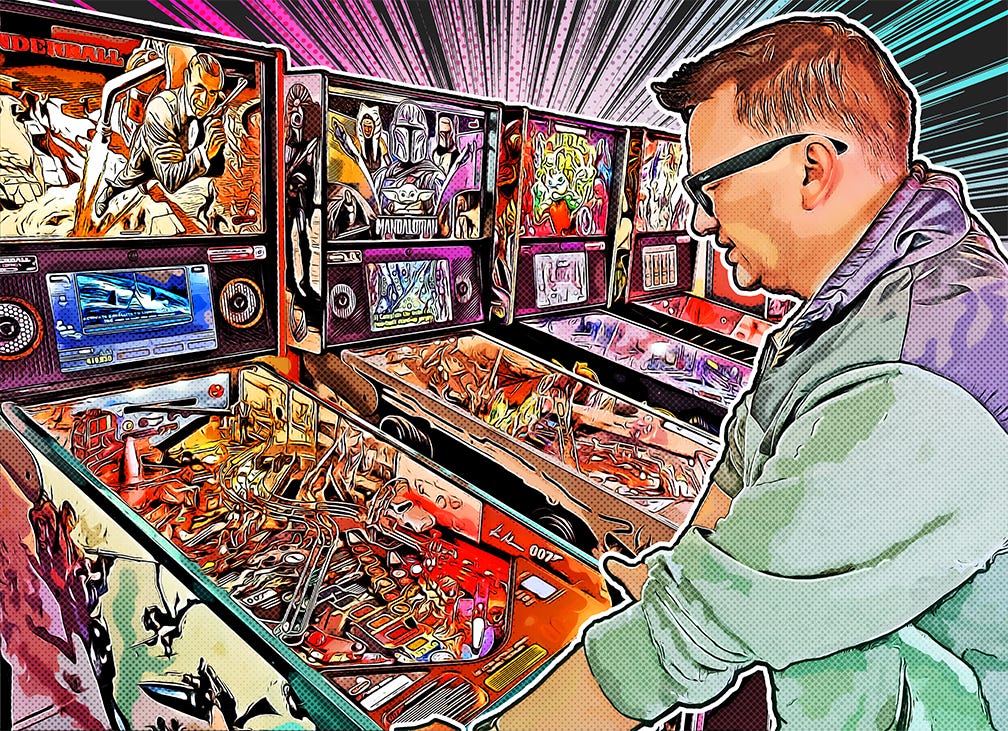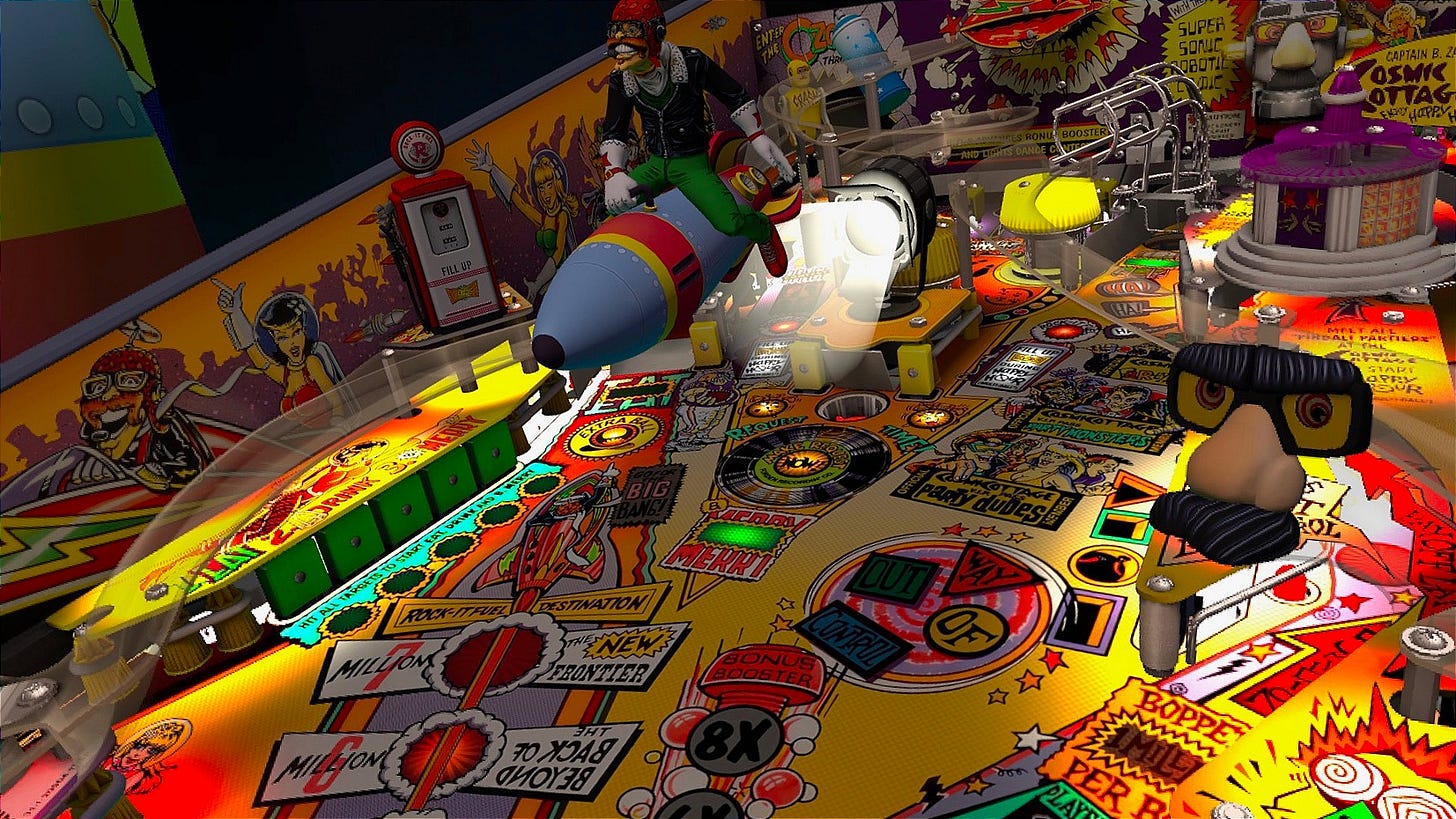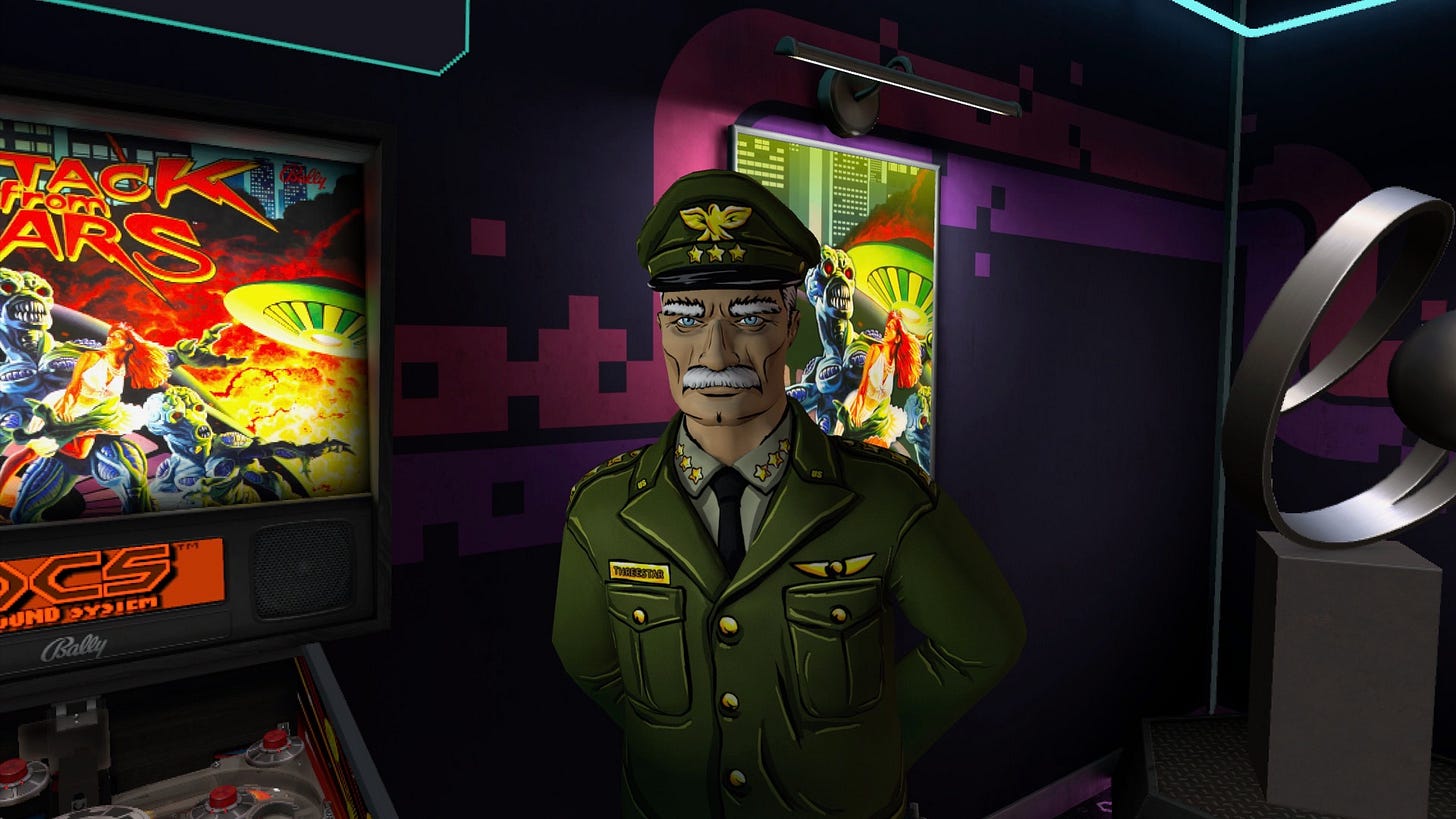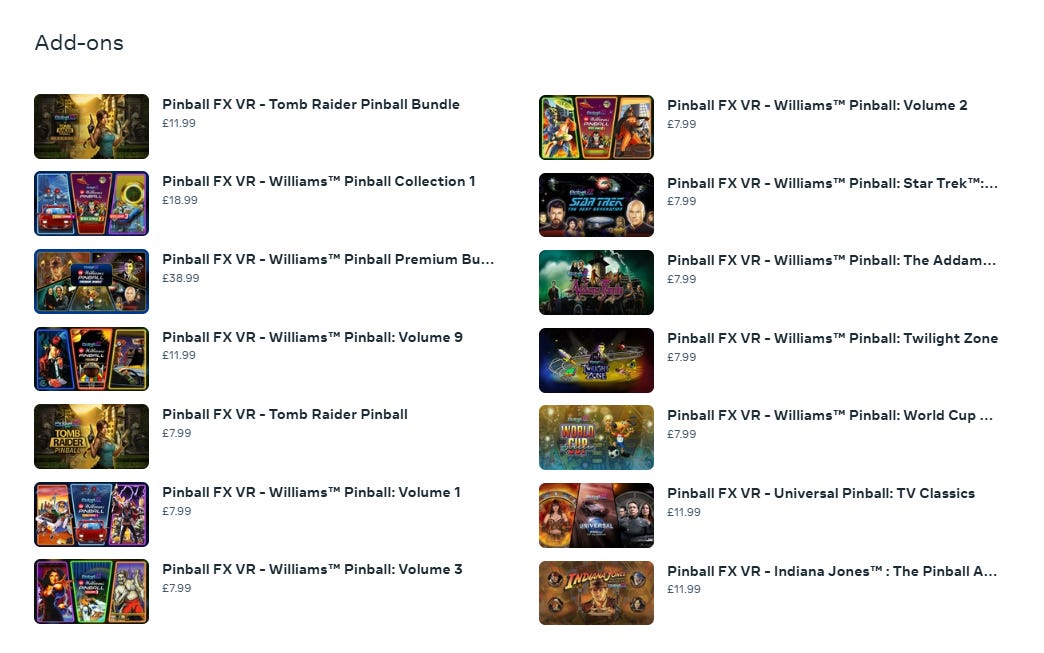ZEN and the Art of Immersive Pinball | Part Two
An analview* examination of ZEN's Pinball FX VR. (*analysis-review)
Hey-hey! Welcome back Pin-Bud! Hope you had fun last time, because this time we’re going all in, beating this latest game to within an inch of it’s life. If you missed it, or you’re too drunk to remember, click the link just below👇. Otherwise I’ve pumped the machine full of credits already, so let’s just get on with it and launch our first ball already.
“Ever since I was a young boy, I’ve played the Silver Ball”
Budapest-based developer Zen Studios have had an 18 year history of building digital pinball games for PC, Console and Mobile platforms. CEO Zsolt Kigyossy is a self-confessed pinball fanatic, and set the goal of making the best pinball simulation on the market. Over nearly two decades, they’ve steadily marched towards that goal across a wide and confusing lineage of pinball titles. It’s first game was the original Pinball FX (2007), published by Microsoft, and was a huge hit on Xbox 360. Keen to bring the title to the growing PS3 market, their existing publishing deal meant Pinball FX had to stay an Xbox brand, and so the team built Zen Pinball (2008) for Sony’s platform (and eventually used the new brand name for other platforms too). Over the years they’ve built licensing deals with Marvel, Star Wars, Valve, Fox, NBC Universal, Legendary and a host of other media giants to create tables based on popular intellectual properties, as well as licensing official Bally Williams pinball tables and creating plenty of their own home-brewed table designs with popular archetypal themes (Witches! Greek Gods! Funfair rides!).
Zen, then, have a busy, coal-face history of designing, creating and shipping digital pinball tables, and since 2016’s team-up with Oculus (pre-Zuck), have been at the forefront of trying to make Immersive VR pinball a reality too. Despite missteps along the way the studio seem to have a genuine love for the medium, and still seem to be keenly pursuing Kigyossy’s original goal of creating the best and most authentic pinball simulation possible. In a lot of pinball fan’s minds, they’ve always been seen as the team best positioned to make commercial VR pinball a success. The years of silence after the poor critical and fan reception of Star Wars Pinball VR in 2021 looked like Zen had parked their immersive plans. Instead, they had been charging ahead at full speed, working on their most ambitious XR title to date, one that has taken careful notice of most of the issues that have plagued their previous attempts.
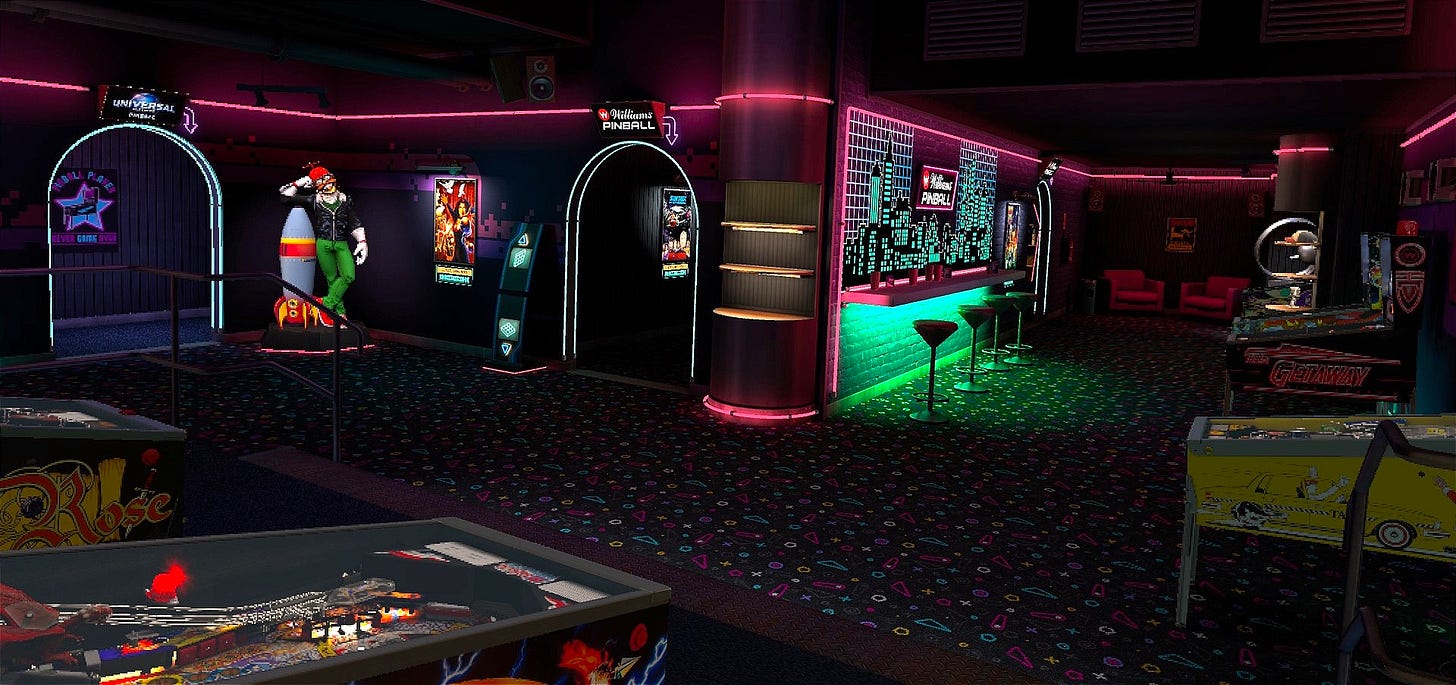
“See Card for Table Rules”
The setting of Pinball FX VR (PFXVR from here on in) is an evolution of the same ‘mancave’ idea from ZEN’s previous titles: have your very own ever-growing Pinball Arcade, now accessible in VR and MR, that has a degree of permanence and personalization. It’s already full of tables (and the number has grown considerably since launch) for you to play, with every table offering a fairly generous time-limited demo mode that you can play over and over without needing to buy the table. Tables you buy become unlocked from this demo mode, and your purchase gives you full access to the table - this includes a campaign mode with unlockable rewards, game modes like timed mode (5 minutes to get the best score, infinite balls), flip mode (the game ends after a certain number of presses of the flipper buttons), survival (beat increasing score targets to stay alive as long as you can), and one-ball mode, where you try to reach your highest score with only 1 ball. There are others as well, plus practice modes and then expert versions of the table with a steeper playfield incline leading to faster ball speeds and shorter reaction times. Leaderboards, rewards to decorate your pinhall as you ‘level up’ the table by completing goals. That sort of thing. It’s a lot, and rather than being pointless ruleset twists, many of these modes are arguably more entertaining and rewarding than the traditional 3-balls and you’re done format you know from playing real life pinball. Especially while you’re learning the gameplay nuances and learning the key shots for each table.
My personal hopes were high going into this. I’m generally a fan of any and all pinball — more pinball is always good — but I’m particularly attached to my favourite real-world tables, and what I’ve really always wanted is a way to be able to play these tables at home, and have those skills translate directly into better performance the next time I get chance to drop a quid coin in one of these machines out in the wild. That requires more than just an accurate simulation of the physical properties of the table layout, the gameplay rules, and the ball behaviour. It also needs to nail the ‘feel’ of playing that can be directly compared to a real table, and that’s often been an impossible task for traditional videogames. Think about it like screen-based versions of Billiards or Golf that can teach you the rules and scoring, the angles and the approach, how to judge your shots — and that’s all really good knowledge that can translate directly into a real world situation. But when you get to the sports bar or out on the golf course, there’s no correlation between how you mechanically interacted with those systems on the game screen, and how hard you need to swing your club or shoot the cue ball in real life. One of VR’s great immersive benefits is that it naturally closes some of that gap by virtue of you now physically interacting to pot a ball or swing a club. The weight’s all wrong and there’s no table to lean on, no feedback feel from striking the ball and so on - but some of the gap has been crossed. VR brings us closer to the real world experience of those activities, even though there are still critically important elements it can’t reproduce.
For virtual pinball there’s the potential for it to be much closer to reality, because the player’s scope of physical interactions is far more limited. For the pinball feel, you need to recreate flipper buttons that are already digital in nature, a plunger that is effectively just an analogue power setting for launching your ball, and the ability to physically nudge and tilt the table within a limited allowable range (too much or too often and you’ll get a ‘Tilt’ and lose your ball). The only other interaction the player needs is the ability to move their head around to properly view the table - which can’t be understated in it’s importance in learning shot direction and timing and being able to see important playfield labels and indicators that can often be hidden or de-emphasized from a fixed 2D perspective. We still can’t make this a 100% accurate simulation of real life pinball yet, but the magic trick of VR has always been to make these simulcra feel completely believable in the moment and keep you immersed and engaged to the point that you don’t notice the missing parts any more.
“I call this game Fun in a Box!”
So my hopes were high that any hours ‘wasted’ in a virtual basement playing pretend pinball could actually translate to some tangible benefit in a real world match against my mates. I’m totally here for wasting my time on any pinball games, but I will choose a recreation of a real table over a digital-only table every time. One of the key opportunities with digital pinball is that you could go beyond the laws of nature, mechanical design and costs, and make a virtual table do things it couldn’t in the real world, the design no longer needing to be shaped by the absolutes of real world weight and gravity.
Digital-only tables, like Zen’s in-house designs, can present us with playfields that can routinely change mid-game, integrate fullscreen videogame sequences, feature animated characters and elements that roam the playfield and affect the gameplay, or showcase the effects of fires, explosions and winds that impact the path of the ball in ways that mechanical magnet tricks can’t match. Any of these things can add unique gameplay elements that go beyond the real life experience. I enjoy when games go this way and incorporate these clever and unusual elements well but they always feel unreal. They’re impossible additions conjured with digitally simple solutions. Totally valid, and please keep doing this, but for me these are a different strain of pinball that scratches a different itch, and those impossibilities tend to erode some of the purity and satisfaction that I find inherent in real life pinball. As I wrote last time, to me the magic of pinball comes from a fascination with how the physical design, mechanical engineering, gameplay rules and experience design all come together through some strange alchemy to make this box of self-contained wonder. To quote the Cat in the Hat, ‘I call this game fun-in-a-box’.
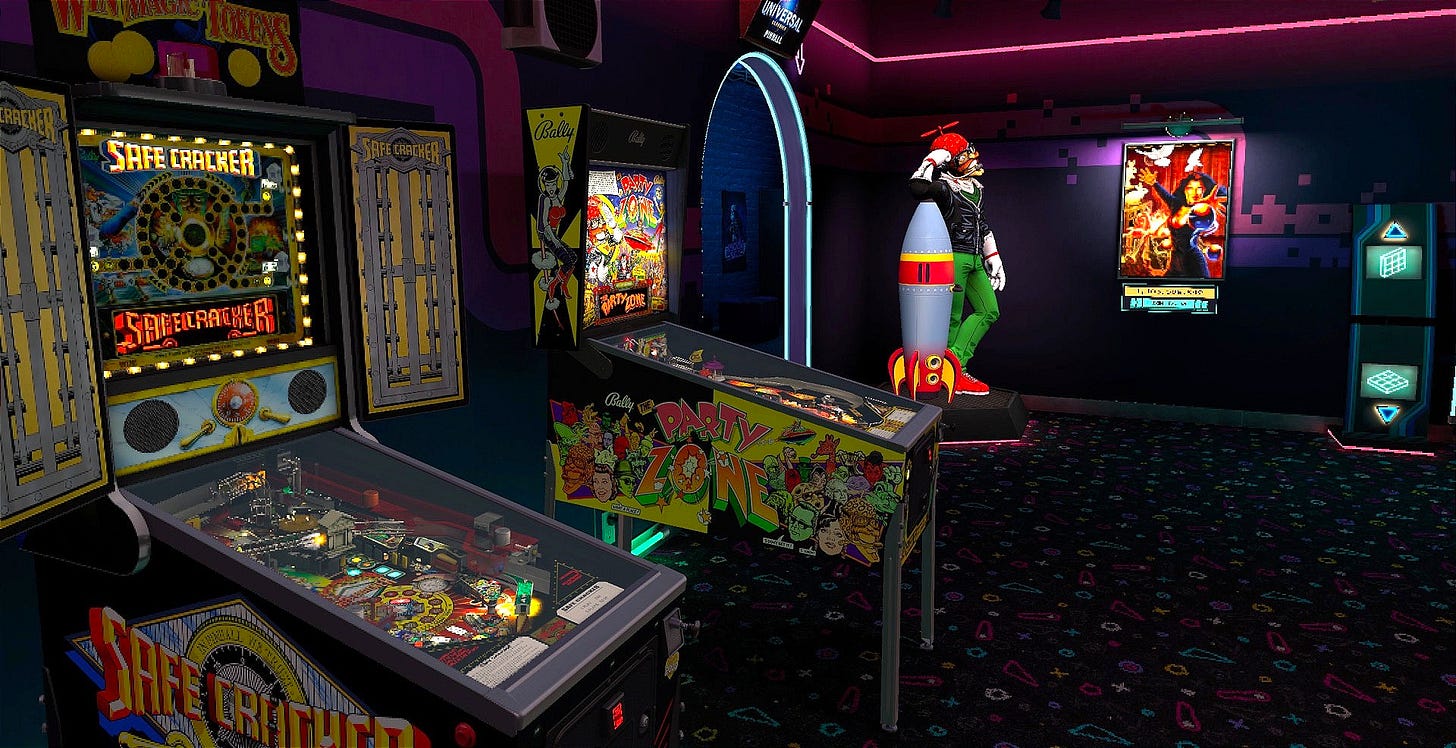
“Hold Flipper for Status Report”
Upon it’s April 3rd launch, the title was in surprisingly good shape, making an excellent first impression on users. What few niggles and bugs were to be found were often frustrating, but could be accepted as teething troubles. The bigger debate was around the price commitment of buying (unlocking) the tables — a big question I’ll come back to later — and the future plans, with little known about whether this was going to be treated as a proper digital pinball platform in the style of pancake Pinball FX (with over 100 tables on offer and still growing), or one that’s destined to be marked complete after a few more DLC tables, in the style of their two previous VR titles. From Zen’s position I can imagine this could be entirely dependent on the early response from the buying public, especially after the mauling that Star Wars Pinball VR continues to receive in store reviews to this day. There didn’t seem room to fit many more pinball tables into your digital pinball cave, either, which some fans took to signify that after a few more tables were squeezed in, a line could be drawn neatly under the project if it didn’t perform well enough.
The good news is that Zen have surprised on this front and the signs look good. The initial launch version came with 3 tables fully unlocked, all Zen ‘homebrews’ (Curse of the Mummy, Pinball Noir, Sky Pirates) with 5 of the world’s most popular Bally/Williams tables (Indiana Jones, Addams Family, Twilight Zone, Star Trek TNG, and World Cup Soccer) also available to buy either individually or as a DLC bundle.
A month later, 9 more classic Williams tables dropped across a trio of 3-packs (Getaway High Speed II, Junk Yard & Medieval Madness / Black Rose, Attack from Mars & Party Zone / Theatre of Magic, Safe Cracker & Champion Pub) meaning suddenly we had 14 of the best and most popular real-life Bally and Williams tables of all time, perfectly replicated as full-size, fully working virtual versions that looked, played and pretty much behaved exactly like the real tables. For those of you wondering since the last newsletter about whether or not I lost my shit and went on a spending spree, well… Yes I did. And this was the moment. I bought the entire bundle with all 9, then went back in 3 hours later and bought up the other bundle with the first 5 Bally/Williams tables. In my defense, they were all discounted at the time so, y’know, I was actually saving money. Ahem.
Adding fuel to my buying decision was the sight of the arcade footprint expanding with a new room for these 9 new tables. Concerns about not being able to squeeze more tables into the existing floorplan had been rendered moot. Through clever layout design, many of the machines are occluded from view at any given time, but there are still spots where you can see as many as 11 machines blinking and plinking away around you, and walk right up to them and examine them in detail. It’s seriously impressive that Zen have this running seamlessly on a standalone like this.
It didn’t stop there. A month later we saw a pack of tables based on licensed Universal IP (Xena: Warrior Princess, Battlestar Galactica and Knight Rider). I like to think of this as the VR Dads pack for obvious reasons. Nostalgia has the power to make a TV show about a talking car relevant in a time when talking cars, phones, sunglasses and even fridges are becoming our every-day. Of course, the real draw here was my secret hope to have a full size Lucy Lawless screaming her ‘Lalalalalalaaaaa’ Princess War Cry(tm) right in my face, but sadly that hasn’t happened yet. Still, VR is made of pure dreams, so anything is possible.
More recently, we’ve had another 3-pack of classic Williams tables (Taxi, WHO Dunnit, and PinBot) and a set of 2 new ZEN-designed tables based on Tomb Raider. That brings the total of pinball tables in your underground Pin-Cave to 25, all of which are playable, at least in limited time form, in the base game. And along the way, ZEN have fixed the vast majority of the niggles and bugs that were present at launch.
That makes the £7.99 / $9.99 asking price for the base game seem very reasonable, all things considered. But I’ll come back to pricing later.
“Press Start To Play”
So, to the most important stuff. How does it play? Is it immersive? How does it feel?
To cut to the chase, it’s excellent. This feels the closest to playing real pinball table out of all the immersive pinball sims I’ve tried. Zen have really delivered on the fantasy here, and CEO Zsolt Kigyossy’s long-held dream of building the best pinball simulator on the market has, in my opinion, finally hit the jackpot.
On a visual level, Visual Pinball VR on PC has the advantage if you’re running a decent GPU under the hood, but PFXVR is doing amazing things considering that the Snapdragon XR2 Gen 2 beavering away isn’t nearly as powerful as most gamer’s GPUs. This game looks fantastic running on a base Q3, and looks even more astonishing when running through my best pal, Quest Games Optimizer.
I had been wondering whether I should wait to see if a PSVR2 version was in the pipeline, but as soon as I played the Base game with its 3 tables, I realised that through QGO, this looked so good that I no longer cared. (I mean, it’s me, so I’d probably buy it again on PSVR2 anyway because I’m a sucker for that screen, and the Sense controllers and head haptics might make it even more amazing. But no way would I buy all those tables again. I’d just use the included 3 tables to analyse the implementation from a professional point of view. I absolutely would not lose my shit and buy all the tables again, again. Come on, you know me better than that).
I don’t need to say much more about the visuals - you can see them all over this article, all taken in-game using QGO during my many play sessions. It looks great, runs smoothly 99% of the time (expect consistent dropped frames and stutters as you exit a table under stick locomotion, but otherwise it’s generally butter-like), and everything is perfectly readable, if a little softer, running without QGO. You won’t be disappointed, it’s a real looker.
It’s immersive too. The place feels like a place. The layout is kind of organic and unusual and feels exactly like the sort of underground bar you might find in a big city. A Cavern-like series of rooms and odd spaces where somebody’s bought up a bunch of neighbouring basements and knocked them all through to form a warren of individual game rooms, forced into different elevations and expanded into funny little corners.
It’s a real departure in feel from Zen’s other VR pinballs which aimed to make you feel like you were living like the wealthiest pinball fan in the world. PFXVR makes you feel instead like you’re visiting a secret underground pinball wonderland that no one else knows about. It’s still aspirational, but in a very different way that felt closer to my real life pinball experiences, and further from the realms of Tony Stark Malibu-Mansion fantasies. I don’t feel like I own this place, but I do have exclusive private use of it. I’ve paid my moneys to be able to play the tables whenever I want, however I want, and whenever I visit. VIP and it’s all for me. It’s a Michael-Jackson-hiring-out-Disneyland vibe, or renting out a cinema screen on one of those birthday packages, and then not inviting anyone else.
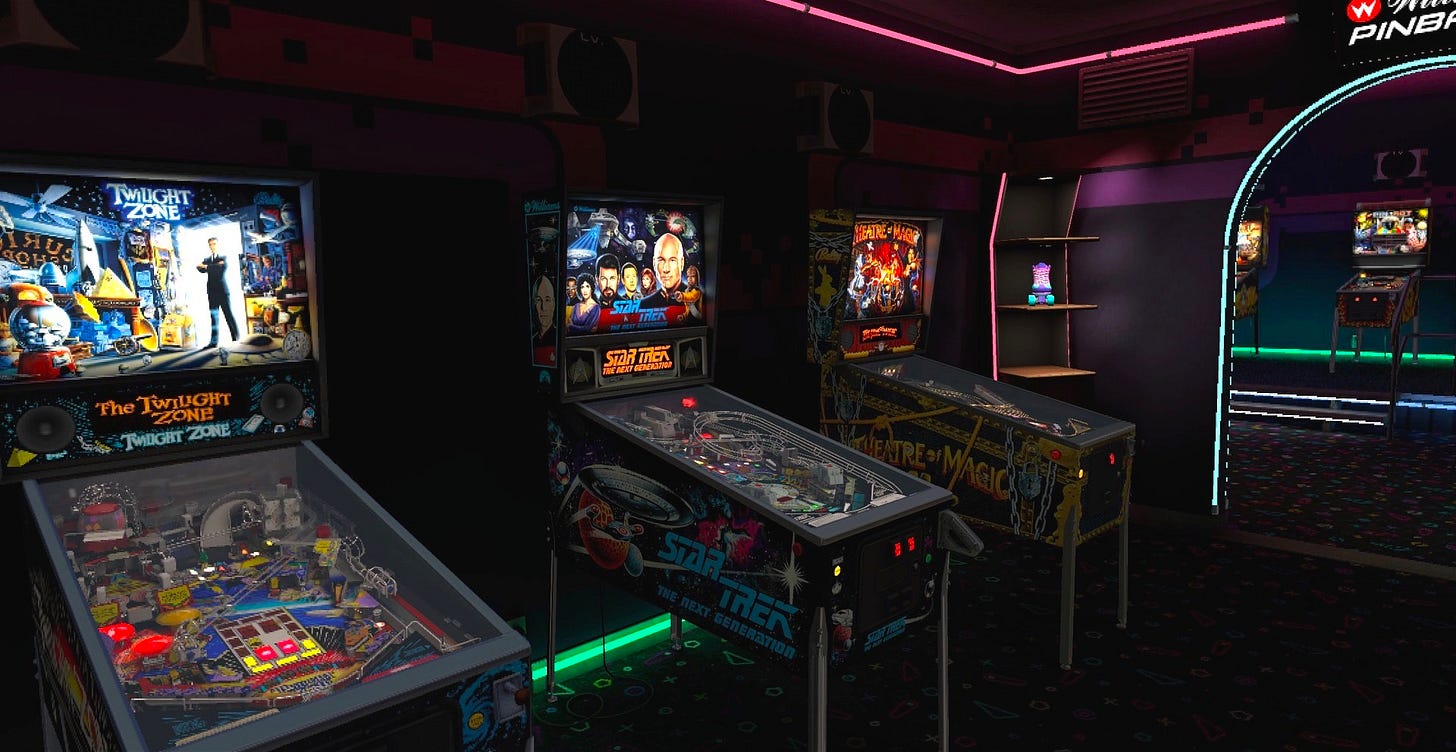
Each new DLC drop has been expanding the arcade in unexpected directions, and this feeds into the organic feel of the space. I’m fascinated to see how the next construction work on this establishment goes and what weird space they expand into next. Experientially, there’s a slight downside to this, I guess, in that if you want to immersively wander around the place the movement speed means it can become a bit of a chore. I bought this game for a mate for his 55th birthday recently and when I asked what he thought, his very first response was to moan about much teleporting around was needed, before he ever mentioned anything about the pinball action itself.
The game doesn’t really help this by having the unlock system reward you with prize tickets to go and gamble on a random-payout wheel-of-fortune which is all the way up at one end of the long thin layout. If you’re anything like me or my mate Bob, you’ll want to eagerly run and cash in those tickets as soon as you earn them, and then come straight back and see your new ball trail or flipper design in action on the table itself. If your pinball table was down the other end of the Pin-cave, it can take a while. Teleport jumps will get you there a little faster and more comfortably, but have no helpers or logic to interpret your intentions. It’s easy to accidentally turn a few degrees every flick forward, which ends up spinning you sideways, carving a drunken curve towards your destination. An update did drop a few days after our conversation that lets players now teleport directly to any table by clicking on the map, which does costs in terms of the immersion, but saves on virtual shoe leather.
In terms of embodiment, the game only stumbles a little. You have hands and arms up to the shoulder but no body, which is the perfect choice because hands and head are all that matter in pinball. The IK prediction of your elbow and upper arm position is well implemented, which is impressive. Your limbs are customizable, so you can swap skin tones, make them semi-transparent, or just swap in some bionic terminator arms for shits and giggles.
Your hands stay pinned to the flipper buttons when you’re playing, but real life controllers tend to roam about in space so Zen have made the choice to snap your hands into place within a very broad target zone around the flippers, which becomes a problem when you try to remove them to shift to the plunger and needs careful and deliberate movements. Some tuning of the targeting zone size is definitely needed to pull your hands away from the flippers more naturally.
You also get to access a wrist-based interface (a VR classic at this point) which is nicely implemented on the whole, but all of the popup panels need to deliver more tactile satisfaction. There’s an absence of physicality to the buttons throughout, with no real animation or feedback when you make a menu selection. GUI panels will pop up when you approach machines, and they stay spatially locked to the machine position. This works well when you’re roaming, but when you’re trying to play a game the pop-up menus before and after a game are using the same spatial locks, and depending on how you position yourself over the pinball machine, those menus can pop up right in your face. It’s a pain if you play seated in a fixed chair, as you can’t easily move back to see the menu or click anything to proceed. Zen have thoughtfully included a setting to offset your position at tables so seated players can tune the best view, but those GUI panels ignore those offsets. If you play standing up it’ll be natural to just take a step back so not a problem there.
Rather than the full environment reworks everyone loved in the original Pinball FX2 VR, the visual enhancements in PFXVR amount to characters and/or scenery props to either side of the pinball table, combined with animated effects on and above the actual playfield, similar to the style of their 2D Horror-based Pinball M offshoot. The quality and appeal of these can vary. They’re cool, but in some cases they can be distracting, and in the worst cases can obscure your view of the table action and impact your score. Characters are often rendered in a heavy brush stroke comic book style, looking like the six-inch cabinet versions scaled large. It’s a stylistic choice which eases the technical load, but visually doesn’t always seem appropriate or appealing, especially as others, like Indy, have gone for a more realistic look. The playfield effects are more successful on the whole, but as lovely and VR-cool as they can be, I appreciate being able to turn them off and play the original machines as nature (and Bally/Williams) intended. For me that’s when it’s easiest to believe I’m playing real pinball.
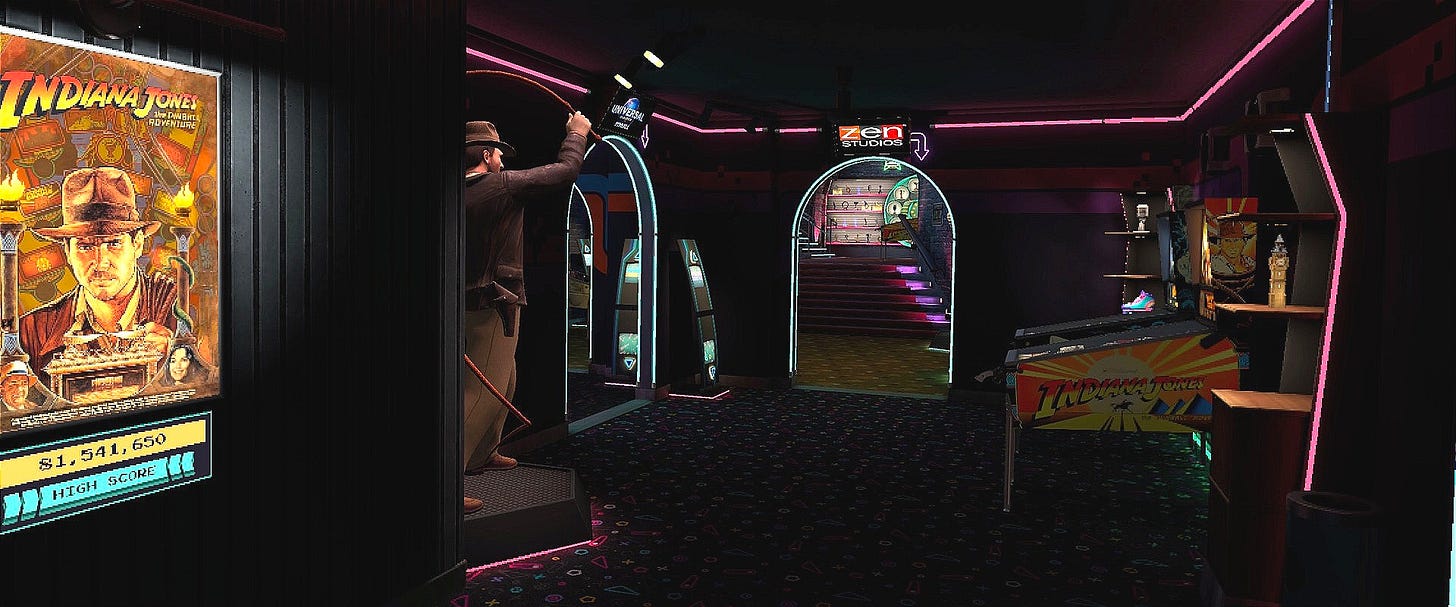
“Welcome to my realm!”
You’re given some freedom to customize the Pin-cave, with wall textures, carpets, decorations and overall architectural style theoretically able to be tailored to your liking, and you can swap around the tables within their designated rooms. Most of the decoration options are gated behind progress thresholds, though, and Zen have always had a bad habit of keeping the nature of these thresholds somewhat arcane and awkward to access. Expect to be peering at tiny text on small icons to puzzle out opportunities and putting in the work to be able to really make the space your own.
Everything is unlocked through spending tickets on the wheel of fortune, but the redeemable choices are themed around the table you won the prize ticket on. Win a ticket on Addams Family, and all the prizes are Addams Family-themed unlocks (posters, new ball skins, flipper skins, ball trail effects, or maybe a figurine for one of your shelves or a life-sized statue to replace the one abstract sculpture that populates the starter arcade). The spins usually seem to give you things in the same order though, and the way the wheel slows down to a stop really appears rigged to land on a pre-determined spot sometimes, it’s quite funny. After around 80 hours on this game I’ve got plenty of posters, ball designs and a few shelf trinkets and statues - but I’ve only unlocked 1 new carpet choice, and 1 new wallpaper, and have zero idea what I did to earn those tickets. I’m getting pretty sick of the vomit-yellow carpet I’ve been using. And it has to be said, I’ve unlocked way more posters than there are slots on the wall, but all my shelves still look pretty devoid of toys and trinkets. For some it’s a minor thing, for others it will be a play driver, but it feels like tweaking the distribution and cadence of those rewards (and making the wheel appear more random!) would probably make the game more sticky - with the way the ticket system currently works, those later tickets will be locked behind fiendish challenges and that difficulty curve could leave some players with pretty empty looking Pin-Cave environments, but a whole collection of ball trails and things that you’ll rarely care to switch between. Another fix might be to let players duplicate objects on their shelves - once your trinket is on a shelf you can’t use it again anywhere else. I can’t imagine the harm in letting you put 50 tiny Xena figures all around your Pin-cave if you wanted to, and it’s not like anyone else is going to see your personal Tilt dungeon.
And that’s a score penalty against the title that needs mentioning - there’s no option to play this multiplayer, except by maybe handing the headset around. This seems like a crazy oversight and probably something that will get rectified at some point, because every non-VR version of Zen’s pinball games has let you play with up to 4 players. Sure there’s some design challenges around letting 4 people crowd around a machine believably in these fairly restricted spaces, but that’s a problem real pinball faces too, and it’s far easier to address in a virtual environment where people are just ethereal heads-and-hands than in the hard physical confines of real-world bars, arcades and gaming halls. As this Pin-cave gets bigger, it’s going to feel a lot emptier without others around.
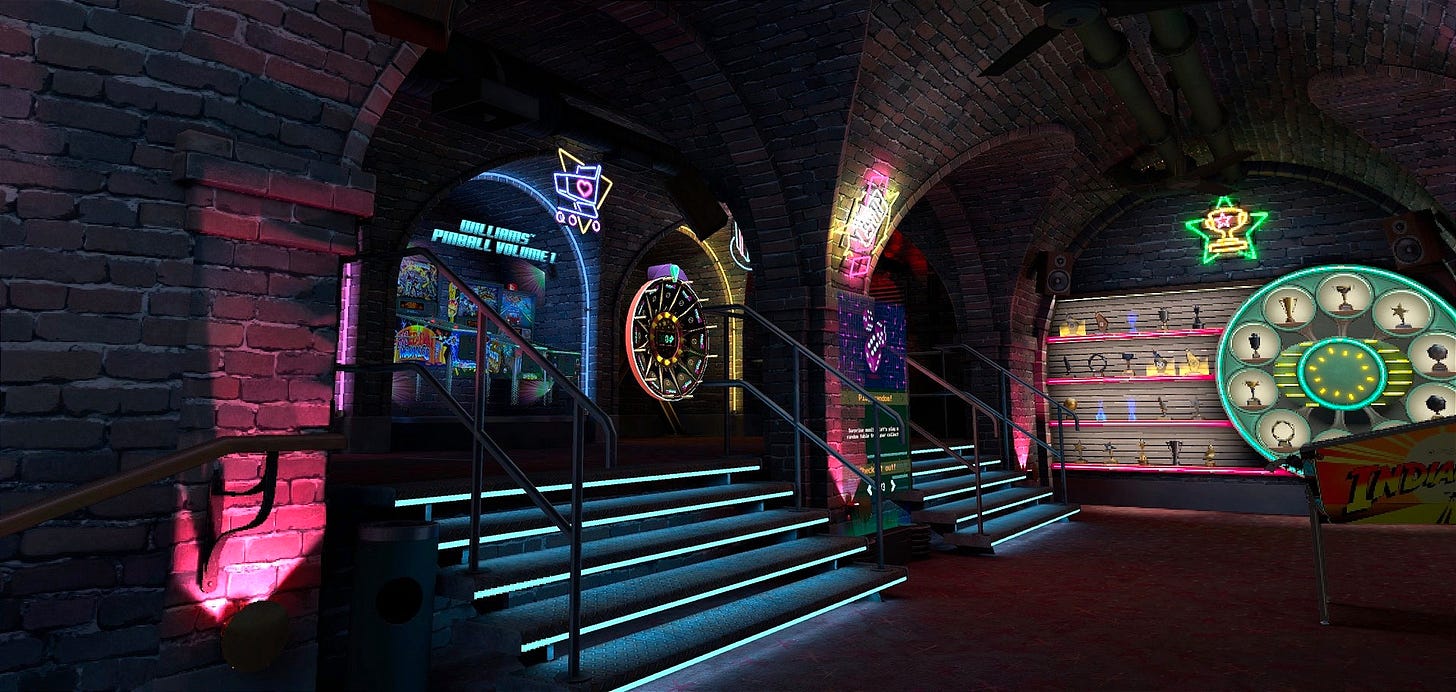
Another score deduction comes from the pointless Darts machine that takes up a good spot in the main arrival area. We’ve all played Darts. I’ve played lots. I’ve even advised on a couple of games to help them translate the feel of darts into VR. So I know it can be challenging to capture the experience. Throwing these little arrows simply does not feel like darts in any way to me. It might be a fun extra if it were tuned but honestly it feels like it was made by someone who’s only watched darts on the telly.
The Pinball machines (and a pointless drinks machine) can be activated with coins you might accidentally discover you can pull out of your back pants pocket, which is neat but more work than just clicking to play a table (and you can’t open the cans or do anything with them. Letting you guzzle a drink in VR is like a baseline interaction in VR these days, so it’s a bit weird for Zen not to let you pop the can). Equally falling short is the interactive cassette deck on the reception desk, which lets you insert collectable 80’s oldskool audio cassettes which you periodically earn, but which seems extremely fiddly and unreliable to operate in that traditional VR I’m-wearing-four-pairs-of-rubber-gloves style that makes you wish you could just press a controller button and be done. These things are neat ideas for interactions and just need a little tidy, but they still rub against the sheen of the game a little when you encounter them.
And let’s not forget the neck strain issue that’s always been present with VR pinball. Real pinball can give you a crick in the neck if you play long enough, but the additional weight of the headset will bring that around much quicker. And without being able to lean on the virtual table as you bend over it, playing this standing can get tiring quickly. Zen’s solution is to allow you to tilt the table view by tilting the whole world, which is generally recognised as a dangerous thing to dabble with, comfort-wise. Because all of the tables are positioned right against a plain-ish back wall and you’re absorbed in the action on the table itself most of the time, there are few visual signals that anything is awry, but turn your head 90 degrees either way while you’re playing and I guarantee you’ll notice it and may need to steady yourself. In my head I keep wondering if leaving the virtual scene locked to the RL horizon and just tilting the table itself would work, like you’ve extended the back legs a little. The ball movement and physics would feel unrealistic for the steeper visual slant of the table and this would cause a different (possibly worse) disconnect for the player. Bear in mind that racking up the rear legs a little is already something pinball halls can do to make the game harder, so for the more experienced wizards familiar with playing at different inclines, this might feel even stranger. Zen have probably picked the smartest solution, and it’s interesting to think the need to comfortably tilt the table view might have significantly influenced the design and location choices that make it sensible to have all the tables pushed up against walls. It’s a definite departure from their previous VR approaches of free-standing tables.
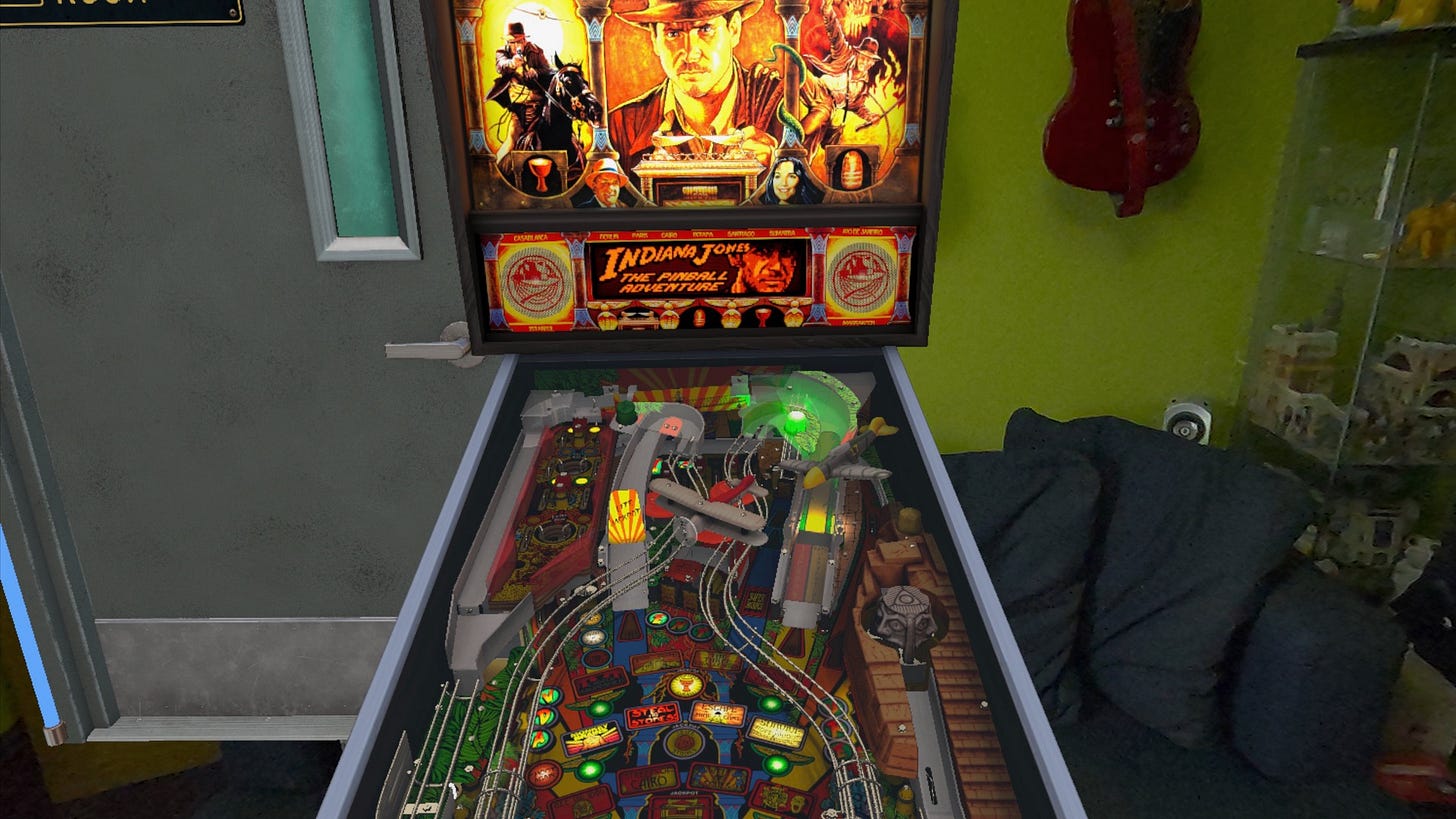
“Welcome … to the Theatre of Magic”
The Mixed Reality mode is my dream come true and it does exactly what it promised, but it’s still a little bit disappointing. The implementation of dressing the space with virtual elements feels a little clunky overall. For instance, there’s a persistence issue if you change rooms / playspaces a lot, as elements will sometimes get left behind and you’ll literally have to walk to your other room to grab them and access them, which was something I’ve never had to do before with MR and feels like a crazy oversight. A more common practical issue for most will be that the pinball tables seem to demand an oversized space to be clear when setting them up, with loads of space to the left, right and behind, keeping them away from your physical walls. Once you’ve dropped the table you can manoeuvre it where you want to (but again, you’re still constrained by your real world walls - it would be a nice option with these big tables to let users ignore those bounds and depth conflicts, like MiRacle Pool allows with it’s life-sized Pool and Snooker tables that otherwise wouldn’t fit in the user’s room). I think the extra space requirements are to make room for the ‘enhanced environmental effects’, like full-size animated characters gooning next to the table while you play, but I don’t remember seeing an option to turn those off, freeing up the space, until after the MR table is placed.
While you can put your virtual unlocks around your real room, the posters don’t really adhere to your scanned wall, floating in front of the mesh and often objecting to seemingly valid placement choices. The shelf toys can be placed on surfaces, but it’s fiddly and you need flat, empty tabletops or shelves in your scanned room to put them on, and that’s more IKEA catalogue fantasy than real life for most people. And that MR ‘options door’ seems huge and unnecessary, and takes up a lot of wall space where you’re forbidden to drop a table in front of it. If you’ve got a small playspace you can cram the tables together, but there seems to be a resolution drop between VR and MR modes if you have more than one or two tables out in-view at the same time, getting worse as you add statues and trinkets to the scene - and this hurts the readability of the table text on the machine you’re playing. The VR version switches you to an optimised ‘instance’ where you’re locked in front of the highest level-of-detail model of your chosen machine when you play it, which is much easier to manage than in MR, where there’s no way to stop the user just wandering off to examine another table while the first one is in full swing. This is an understandable issue, but it means that filling my smallish office/VR space at home with pinball tables is something I can do now (my dream come true!) but the compromises to visual legibility while you’re playing a table means that in practice I would never want to. After all, you can only play one table at a time and they’re quick to swap in a different one. Having other stuff around the room, while pretty, has too big of a trade-off.
Setting your MR experience up, then, could use some tuning and edge-case attention but once you’ve got your favourite pinball table in your living room, office, bathroom, sex dungeon or wherever, standing there playing, it all feels very very cool. Genie Wish granted.
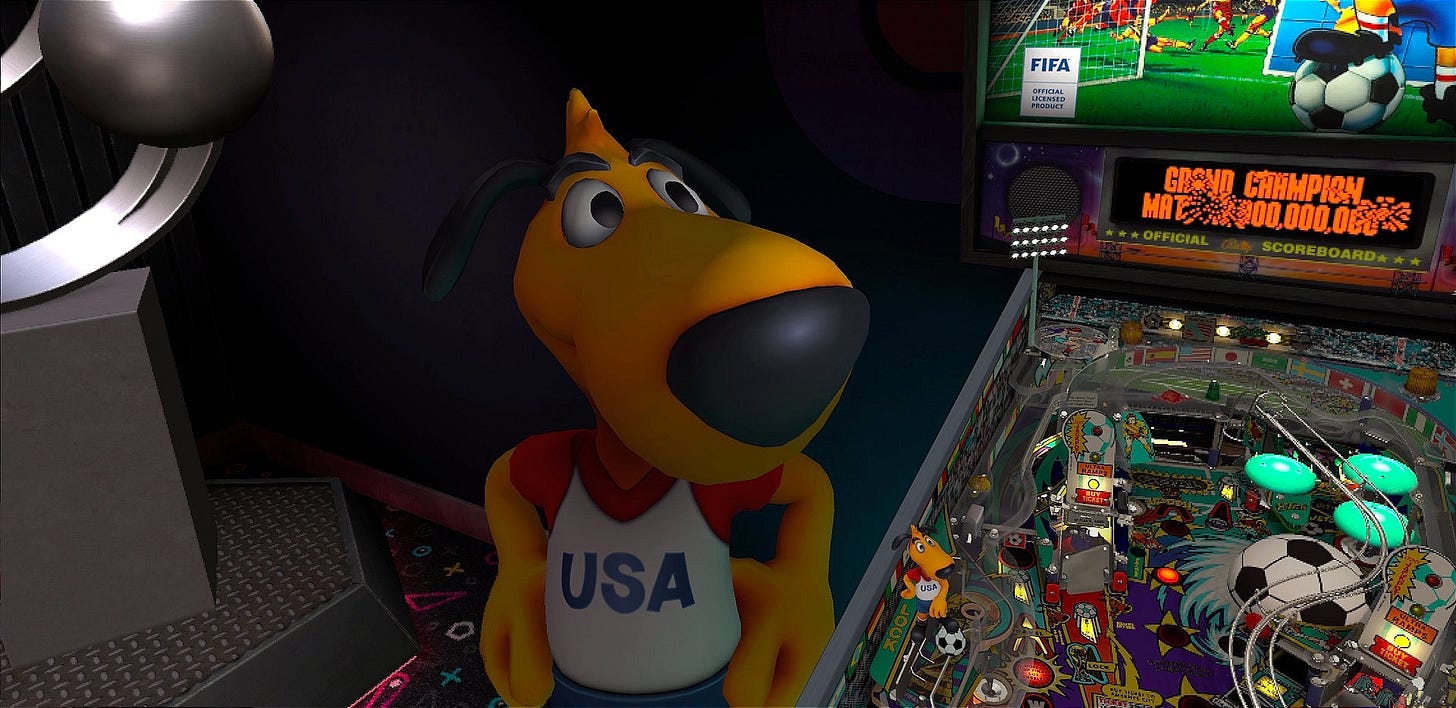
“We’re going to Super Jackpot around the clock!”
There’s been lots of talk from me so far about lower-scoring features, mainly because identifying and addressing issues like that is what I do in my day job and I just can’t help myself. So I’d like to stress again that this game is fantastic. The issues above are there, but none of them are game-killers. This is easily my most played VR title of the last few months and has become the game that pops into my mind whenever I look at my Quest 3.
You’ve probably heard that plenty of racing game fans buy a PSVR2 purely to use it almost exclusively for playing Gran Turismo 7 - because if you’re a motor head or a supercar slut, nothing else comes close. The experience is that good, that believable. An infinite step beyond what a flat screen can offer.
I would say that’s the case here. If you have any love for pinball — and as I covered last time, I believe Pinball has pretty much universal appeal, everyone can enjoy the lightshow and physical fun of flipping the ball around inside a crazy box for five minutes — you’ll appreciate this game, have loads of fun, and it’ll scratch that pinball itch. It’ll improve your real-life pinball skills too.
But if you’re a Pinheaded nerd, a pinball Superfan, or an absolute Gandalf-beard-and-sparkly-sleeves goddamn Pinball Wizard, you’ll probably fall in love with this, hard and completely, Dolly-style. It’s the real deal. The experience is that good, that believable. An infinite step beyond screen-based pinball games. And the fact that Zsolt Kigyossy and his team at Zen have realised this dream at last to this quality level and it’s on the Quest platform is nothing short of a technical miracle and makes me smile thinking about how terrifically delighted they all must be at what they’ve finally delivered after a decades-long quest.
I’ve actually uninstalled all my other pinball games and their assorted table packs from my console and PC (but not VPX on PC, that still rocks hard and has lots of tables this doesn’t). I’ve been playing flat-pancake pinball on the TV for more than four decades to feed my love for the silver ball, but I just have no desire to play them any more. There’s simply no need, I’m leaving them behind.
That good. This is the shit right here.
So to summarise — it’s excellent, the recreations of real life tables are spot-on, it’s excellent, it only costs £7.99 for the base game, and of course I must mention it’s really excellent. So an easy recommend then, Jed?
“Insert Coins to Continue”
Ah, well, yes of course. But also, it’s not so easy. There’s a wrinkle, you see — you have to consider the prices for buying more tables. £7.99 GBP for 3 tables is great base-game value, but buying more tables piecemeal can rapidly get expensive and hard to navigate. An Addams, Star Trek or Twilight Zone will set you back as much again just for a single table. Or you can buy other tables in 3-packs for that same £7.99, or a 2-pack Tomb Raider for the same price… but then other 3-packs cost £11.99. And Indiana Jones clocks in at £11.99 all on it’s own. I can imagine there’s differing licensing costs for particular tables, but it’s confusing for the consumer and doesn’t bode well for any predictability moving forward.
And whether this is good value or not gets complicated depending on what kind of digital pinball player you are, and where you’re coming from.
| PFXVR Prices -vs- Owning real Pinball Tables
Some people have enormous home collections. Table costs average around £4K-£12K GBP for second hand classics in varied conditions, while the latest and greatest new pinball machines can retail up to £15K GBP out of the box. I have a senior programmer friend in San Jose who has a basement collection of around 25 tables they’ve been building over decades. It’s a whole lifestyle thing for them and they’re very serious about pinball (clearly!). It’s a collection that’s kind of the same size as PFXVR’s current catalogue, with a similar number of classic tables in that it makes for an easy napkin comparison. I’d estimate their collection is estimated to be worth around £180K GBP, whereas the complete PFXVR collection will set you back around £100 UK, less in a sale. Even if you add on the price of the headset itself, that’s still an enormous gulf.
If money was no object I’d still rather have the real basement full of real machines, of course (although maintaining all the machines yourself can apparently be a nightmare) but it’s never going to happen. See also divorce. From this perspective, the PFXVR price points seem extremely reasonable of course.
| PFXVR Prices -vs- Playing IRL Pinball
Most of my IRL pinball playing happens one day a year at a local event where there’s a £25 cover charge and then you play as much as you want. That’s great, and I’ll probably play 50 games over the day, so let’s call that 50p per play, but that’s not year-round.
If I go to an arcade bar or pinball café near me in the UK, the current standard seems to be £1-£2 per play, depending on the machine. Older less popular machines might be 3 plays for £2 or something like that. Napkin science says we can generously call that £1 per play, just to keep things simple.
I’m happy to be able to play and practice for ever on a table that I enjoy for the cost of somewhere between 3 and 12 real world plays. Even at the top end, that seems like a good deal to me as a fan. Zen’s own home-brew and IP license tables are more of an unknown quantity so I’m more cautious and would definitely want to wait for a sale unless I’ve heard good things.
| Standard Prices v Sale Prices
Speaking of sale prices, Zen ALWAYS have sales on selected items every couple of months or so, on every one of their platforms. Expect 15-25% off as standard sale discounts a few months after a table launches, and up to 50% sometimes if you’re lucky. Bundles already offer around a 25% discount over individual purchases anyway, and they also drop their inhibitions even further in sales, representing the cheapest way to build your collection. You just need to be patient and keep checking weekly. Beware losing your shit and buying them all in a short span of time due to some irresponsible frenzy of pinball excitement. You’d have to be a moron to do that. Sigh.
| PFXVR Prices vs other pinball games
We looked over other immersive pinball titles last time, but because they’re often on different platforms and need different headsets they’re not really a fair pool of comparison. Just looking at Meta Quest, your options are really this or Zen’s other two VR titles, neither of which is a better bet. Get this new one. Especially be wary of Star Wars which, as mentioned, sadly remains a stinky bit of Bantha-PooDoo to play, even on Q3 running QGO.
If we’re looking at the VR price -vs- Flat Screen pinball prices, it’s still quite easy. At the bottom end, picking up the entire Pinball Arcade collection (Far Sight) would get you around 100 tables, including most of the licensed tables in PFXVR, for maybe £40-50 in a good sale. It’s an older game of course, but it looks and plays fine, if not quite as nicely as Zen’s recreations. If you just want a digital pinball fix every now and again, though, that’s pretty unbeatable.
Keeping it in-house, comparing prices for Zen’s 2D tables -vs- Zen’s VR tables, they’re actually pretty much identical. It’s nice that Zen aren’t charging more even though the VR implementation is a whole different world and much more accurate experience. Sadly, though, purchases don’t transfer across platforms, so if you buy the 2D table you’ll still need to buy it again for VR. And it seems that, at least so far, every new table Zen have released since Pinball FX VR launched has simultaneously come out on both formats. That’s a fork in the road, pay for one or the other, there’s no double-dip option, so I’ve chosen to take the immersive path from this point on.
I mean, it’s just sooo much better in VR. It really is. Did I mention that?
“Thanks for Playing!”
So that’s it. Game over. We had a good run, but there’s no more quarters left. Pinball is not everlasting, but it IS eternal. It is something that is physical and visceral, and has never been successful replicated by other amusement devices in nearly 90 years since it’s modern creation. But now, through VR and MR, Zen have replicated so much of the experience so successfully that I would happily recommend Pinball FX VR to anyone and everyone who enjoys a bit of pinball, and you know by now that I think that means just about anybody. Maybe even you.
To quote probably the most famous figure in pinball history;
“Never underestimate the power of the silver ball, it has a habit of finding its way into a person’s heart regardless of their age.”
Roger Sharpe (the man who saved pinball)
Just don’t blame me if you lose your shit and blow all your monies on pinball. I would never do anything like that.
Until next time,
Jed
Jed Ashforth has been working in the games industry since 2002, and working with VR, MR and AR apps since 2010. He was part of the team that created PSVR at PlayStation, and has worked on around 150 XR projects. He has too many pinball games and not nearly enough silver ball skills to show for it. He helps developers elevate their game. If you’re interested to find out more you can reach him, and check out more of his work and articles, at www.realisedrealities.com.
All of my illustrations and text - in fact everything in this newsletter - is achieved without the use of AI. I like writing, and I enjoy doing graphic design. Call me human, but I like doing the fun bits myself. And I really wish we’d make AI that would just do my laundry and tidy my garden while I got on with that.



